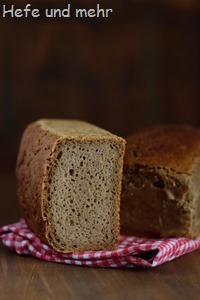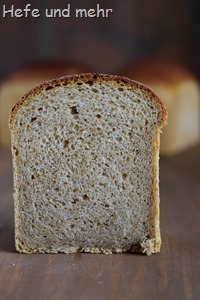You may have already noticed that the english part of “Hefe und mehr” is quite at the moment. And I’m afraid that it will stay like this for longer. We had rough times in the last months, with both sad losses and exiting news. Both consume a part of the energy I invest in the blog. And so I decided to step down for now and focus on the german part – as this language is my native language and writing comes more easily to me. I hope I can add the translations when we reach calmer water again. In the meantime please use google translator to read the newest posts.
Category Archives: Bread
Malty Bread with Seeds
![Malziges Saaten-Mischbrot (1)[3] Malziges Saaten-Mischbrot (1)[3]](https://www.hefe-und-mehr.de/wp-content/uploads/2019/12/Malziges-Saaten-Mischbrot-13_thumb.jpg) This is a typical blogger problem during the winter months: the daylight vanishes at the same time I pull a bread from the oven. If the day was bright enough for nice pictures anyway. The problem can be easily solved with a foto lamp. But with a broken bulb, my studio lamp was as useful for nice pictures as a coat hanger. And so I put one loaf in the freezer and ordered a new LED bulb. Until it was delivered, the weather cleared, too and I was finally able to take a nice picture with daylight.
This is a typical blogger problem during the winter months: the daylight vanishes at the same time I pull a bread from the oven. If the day was bright enough for nice pictures anyway. The problem can be easily solved with a foto lamp. But with a broken bulb, my studio lamp was as useful for nice pictures as a coat hanger. And so I put one loaf in the freezer and ordered a new LED bulb. Until it was delivered, the weather cleared, too and I was finally able to take a nice picture with daylight.
And I’m very happy, as I like this bread very much. It is a perfect every day bread for lovers of sunflower and pumpkin seeds. Continue reading
Stollen Baking 2019

Like every year I don’t have to check the calendar to know that it is nearly November. A short glance in my blog statistic shows me that from day to day the click number for my Stollen recipe rise strongly. And I knew that you – just like me – started to plan baking stollen now. And while since years I’m happily baking my favourite moist Christstollen I posted some recipe variants in the last years, too. To give you a guide to recipes and tips is here a overview where you can find it: Continue reading
Pommerscher Salzkuchen
 Since I started to collect regional bread recipes from Germany, I struggle with finding recipe from East-Germany. And so I was so happy, when I stumbled about some recipes in an old Diamalt book from 1939. But to be honest, the term “recipe” is very optimistic for the short description in the book. The dough for the Salzkuchen is described as a “Waterdough” and its form as (and this a orignal quote, too!) as “oooo”.
Since I started to collect regional bread recipes from Germany, I struggle with finding recipe from East-Germany. And so I was so happy, when I stumbled about some recipes in an old Diamalt book from 1939. But to be honest, the term “recipe” is very optimistic for the short description in the book. The dough for the Salzkuchen is described as a “Waterdough” and its form as (and this a orignal quote, too!) as “oooo”.
That left me with some question marks in my head. But after some more research I found some other descriptions and pictures of “orginale Salzkuchen”. And with this in Hand I was able to create my recipe.
Mangbrot

The Mangbrot was a favourite of my grandfather. It is a bread with a long tradition in this corner of germany. The idiom term “Mang” means “Mixed” and referred to the fact that the bread is baked with a mixture of rye and wheat flour. Here, like in other region with cold climate and loamy soil, rye and wheat was planted as mixture. So in good years, the mixture contained more wheat, while in bad years the robust rye prevailed the mixture. I considered this fact and prepared already the sourdough with a mixture of rye and wheat flour. This makes the sourdough a bit milder.
Swedish Blackbread with Coffee

In one of my baking course a participant told me about a bread with coffee she ate in Sweden this summer. The idea of swedish breads with coffee are not strange for me. In a Swedish blog I like Sara from Sara Bakar bake already one or two breads with coffee. But I got hooked only now. And so I created a coffee blackbread based on my familiy’s favourite blackbread. And I have to say, the resulting bread was mindblowing! My dearest, who normally never touch a bread with dried fruits, eats so much of it, that one loaf vanished in a blink.
But one could tell what my secret ingredients was. The coffee adds a incredible round flavour with its roasted notes but is barely recognizable. The amount of molasse is moderate so it is well balanced between sour and sweet. And so the bread is great with Cheese – especially with a young goat cheese. But honey or purists version with only fresh butter is dream as well!
Weeknight loaf
 I got a bit to optimistic when I tried the first version of this bread. Adding a big portion of very ripe pâte fermentée was not the best of my ideas, as this brings to much enzymes in the dough and has the same effect like adding sourdough. After 24 hours proofing time the dough was still stable, but the resulting bread lacked volume. A sure sign that the gluten network already started to decline.
I got a bit to optimistic when I tried the first version of this bread. Adding a big portion of very ripe pâte fermentée was not the best of my ideas, as this brings to much enzymes in the dough and has the same effect like adding sourdough. After 24 hours proofing time the dough was still stable, but the resulting bread lacked volume. A sure sign that the gluten network already started to decline.
And so I put the recipe back on my worktable and sat down to write a better version. This time it is a straight dough which develops its flavour during the long fermenting time. Yoghurt and good portion of whole grain flour adds another aromatic notes to the loaf. In this combination, the dough is stable over the course of 24 hours and the breads have a nice volume. Which can be seen in their crumb, too. It is soft and fluffy and can be toasted very well, too! A perfect bread for breakfasts and lunch boxes!
Three Grain Bread (Weeknight version)
Some time ago a reader asked if my beloved three grain bread recipe could be modified so it would use boiled sourdough and could fit in a busy weeknight schedule. As changing from sourodugh to boiled sourdough meant replacing the soaker as well. This are quite some changes and I decided that were to many chances to give away a recipe variant without testing. Around the same time I got my hands on beautiful big mold glasses from Weck (1050ml) . They have straight walls and are perfect for baking breads. When the bread is sliced, its slices are perfectly round. I am totally in love with the new form.
And the bread itself is a delicious as the two other variants. And like always it is a good sign for a favourite bread when I bake a recipe in variants!
Spelt Farmers Bread
 This Farmers bread is the right bread for every one who is looking for a rustic bread for busy weeknights. It uses the same principle like the summer evening bread: boiled sourdouhg. To enhance the sourdough flavour I allowed the rye sourdough to ripen for a long time. This can be troublesome in busy weeks but boiled sourdough has one major advantage: It can be prepared one week in advance. So all you have to do is making it on a not so busy day (maybe at the weekend?) and keep it in the fridge until needed. Then you have a “ready to use” sourdough at hand every day of a week.
This Farmers bread is the right bread for every one who is looking for a rustic bread for busy weeknights. It uses the same principle like the summer evening bread: boiled sourdouhg. To enhance the sourdough flavour I allowed the rye sourdough to ripen for a long time. This can be troublesome in busy weeks but boiled sourdough has one major advantage: It can be prepared one week in advance. So all you have to do is making it on a not so busy day (maybe at the weekend?) and keep it in the fridge until needed. Then you have a “ready to use” sourdough at hand every day of a week.
In this case it is used for flavour and tiny tangy flavour in this bread which contains about 70% Spelt and 30% rye. Such a rustic bread gain a lot from a tiny amount of bread spice added to the dough. I opted for a small amount which only underlines the complex flavours of the long and cold fermentation. But of course you are free to adjust this amount to your taste: use more for a stronger flavour or leave it away if you do not like it. The mixture can be varied as well. I normally opt for same parts of fennel, caraway and coriander seeds. Continue reading
Summer evening bread
 Already with the first recipe for my new “work day breads” there was the wish for recipes with some sourdough. Using a sourdough with a long, cold fermentation can cause problems with both the increasing acidity and the increasing enzyme activity. This can result in a weaker gluten network and a bread with less volume but with very chewy crumb.
Already with the first recipe for my new “work day breads” there was the wish for recipes with some sourdough. Using a sourdough with a long, cold fermentation can cause problems with both the increasing acidity and the increasing enzyme activity. This can result in a weaker gluten network and a bread with less volume but with very chewy crumb.
There are two strategies to cope with this. The first one is using only a small amount of a very active sourdough. The second one is bowling the sourdough to inactivate microorganisms and enzymes. At the same time the starch gelatinise and binds water, which helps to enhance shelf life of the bread. This second strategy I choose for the summer evening bread.

